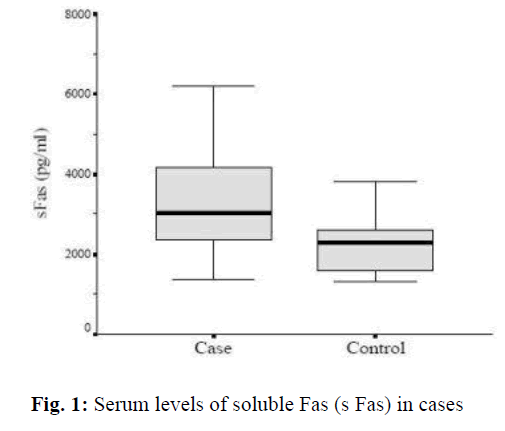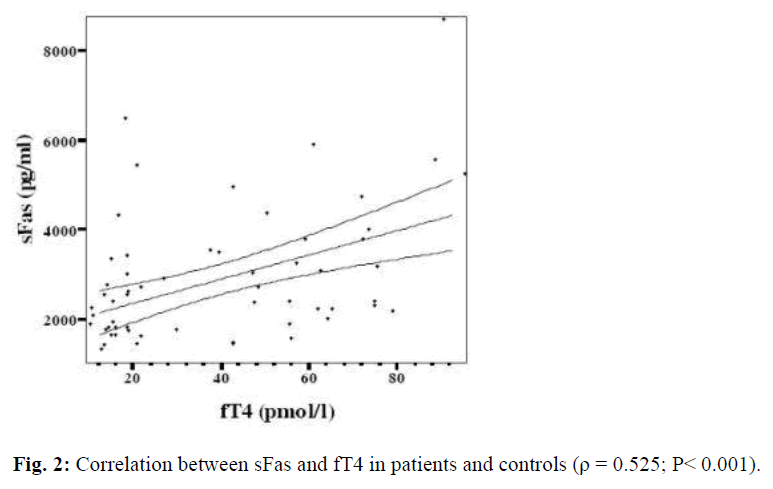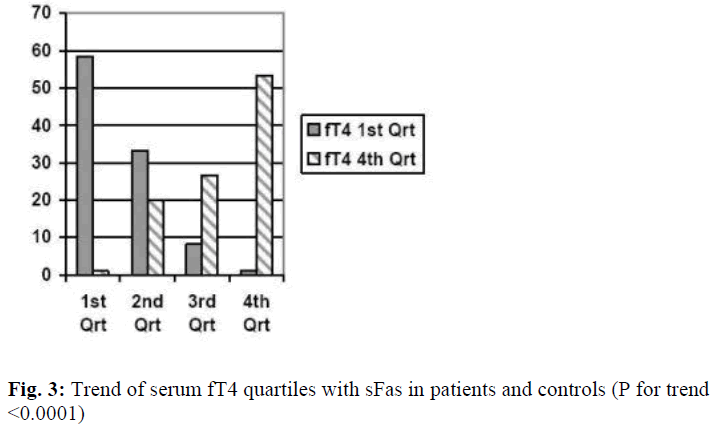ISSN: 0970-938X (Print) | 0976-1683 (Electronic)
Biomedical Research
An International Journal of Medical Sciences
- Biomedical Research (2006) Volume 17, Issue 3
Increased soluble Fas Serum Level associates with thyroid auto-antibody positivity in untreated Graves' hperthyroidism: A case-control study
P. Shooshtarizadeh1, V. Haghpanah1, B. Radjabipour1, R. Heshmat1,2, S. Sharghi1, N. Sedighi3, B. Larijani1
1Endocrinology and Metabolism Research Center (EMRC), Tehran University of Medical Sciences (TUMS), Te-hran, Iran
2Department of Epidemiology and Biostatistics, Public Health School, Tehran University of Medical Sciences (TUMS), Tehran, Iran
3Department of Radiology, Shariati Hospital, Tehran University of Medical Sciences (TUMS), Tehran, Iran
Accepted date: December 27, 2006
Serum soluble Fas (sFas) increases in Graves’ disease (GD) and it may play a role in the pathogenesis of GD through interfering with the Fas-FasL interaction. To determine the association of serum sFas level with thyroid autoantibodies we evaluated the serum level of sFas and thyroid autoantibodies in 31 untreated GD patients and 37 re-lated healthy controls. Serum sFas level was significantly higher in patients (P<0.005) compared to controls. Odds ratios of thyroid autoantibodies serum positivity for serum sFas quartiles were 1.99 (95%CI: 1.2-3.3) for TSH receptor antibodies (TRAb), 1.68 (95%CI: 1.04-2.71) for thyroid peroxidase antibodies (TPOAb), 1.13 (95%CI: 0.7-1.83) for anti thyroid microsomal anti-bodies and 1.17 (95%CI: 0.73-1.88) for anti thyroglobulin antibodies. However, Odds ratios of quartiles of serum titer of thyroid autoantibodies for serum sFas were not significant. There was a moderate but significant direct correlation between serum levels of sFas and free T4 and free T3 (ρ=0.392 and ρ=0.360 respectively; P<0.05) in GD patients.
Keywords
Antigens, CD95, Graves’ disease, Apoptosis, soluble Fas
Abstract
Serum soluble Fas (sFas) increases in Graves’ disease (GD) and it may play a role in the pathogenesis of GD through interfering with the Fas-FasL interaction.
To determine the association of serum sFas level with thyroid autoantibodies we evaluated the serum level of sFas and thyroid autoantibodies in 31 untreated GD patients and 37 re-lated healthy controls.
Serum sFas level was significantly higher in patients (P<0.005) compared to controls. Odds ratios of thyroid autoantibodies serum positivity for serum sFas quartiles were 1.99 (95%CI: 1.2-3.3) for TSH receptor antibodies (TRAb), 1.68 (95%CI: 1.04-2.71) for thyroid peroxidase antibodies (TPOAb), 1.13 (95%CI: 0.7-1.83) for anti thyroid microsomal anti-bodies and 1.17 (95%CI: 0.73-1.88) for anti thyroglobulin antibodies. However, Odds ratios of quartiles of serum titer of thyroid autoantibodies for serum sFas were not significant. There was a moderate but significant direct correlation between serum levels of sFas and free T4 and free T3 (ρ=0.392 and ρ=0.360 respectively; P<0.05) in GD patients.
Our data showed a significant association between thyroid autoantibodies (TRAb and TPOAb) serum positivity and sFas level. It is not clear if sFas elevation is a result of auto-immune process or has a pathogenic significance.
Introduction
The Fas receptor and its natural ligand (FasL, CD95L) are transmembrane proteins that belong to the tumor necrosis factor family of receptors and ligands [1]. They play a major role in maintaining homeostasis in the immune sys-tem [2].The Fas molecule is expressed by various tissues, including the thyroid gland. Activation of Fas antigen on thyrocytes by binding of the FasL, which is present on lymphocytes, is a potential mechanism by which thyroid cells undergo apoptosis [3].
Alternative splicing, results in a soluble form of the Fas molecule (sFas) that lacks the transmembrane region [6]. The killing mechanism of Fas functions via the membrane bound Fas molecule, whereas sFas protects against apop-tosis [7]. sFas is found in low concentrations in the sera of healthy subjects and at elevated concentrations in the sera of patients with autoimmune diseases, malignancy, and inflammatory disorders [8-10]. Therefore elevated serum levels of sFas may have correlation with the activity of these diseases [9,11]. Graves’ disease (GD) is an autoimmune thyroid disorder. It is characterized by the hyperplasia of thyrocytes resulting from stimulation by anti-TSH receptor autoantibodies (TRAb) [12].Although thyrocytes from GD patients express both Fas and FasL in vivo, apoptosis is only occasionally found in the GD thyroids [13]. Some studies have addressed the role of sFas, which suppresses Fas-mediated apoptosis in the pathogenesis of GD. They have shown that serum sFas increases in GD and provide evidences for local production of sFas by thyrocytes and its regulation by cytokines [10]. It has been suggested that sFas may also play a role in the pathogenesis of GD through interfering with the Fas-FasL interaction [10,13].
The precise association of serum sFas level with thyroid autoantibodies is the aim of the present study.
Subjects and Methods
Subjects
The subjects of our study were 31 untreated GD patients (mean age, 38.4 ± 15.7 yr) and 37 normal age and sex matched volunteers (34.4 ± 12.6 yr). GD was diagnosed by suppressed levels of TSH and elevated levels of free T3 (fT3) and free T4 (fT4) and positive TRAb. Normal volunteers had no symptoms or history of autoimmune diseases. The study was approved by the local ethic committee. Informed consent was obtained from all sub-jects after the nature of the study had been explained. The followed procedures were in accordance with the Helsinki Declaration.
Analytical determinations
Serum thyroid peroxidase antibodies (TPO), TSH, thy-roglobulin (TG) and anti TG antibodies (TGAb) levels were measured by immunoradiometric assays (RADIM SpA, Rome, Italy). Serum fT3 and fT4 were evaluated using commercially available radioimmunoassay kits (Di-aSorin, Saluggia, Italy). Quantitative determination of TRAb was carried on using another enzymatic immuno-assay (DLD, Hamburg, Germany). Serum sFas level was evaluated through a commercially available ELISA kit (Bender MedSystems, Vienna, Austria). Reference values were 0.2-4.9 μIU/mL for TSH, less than 40 ng/mL for TG, 3.4-8.5 pmol/L for fT3 and 10-30 pmol/L for fT4. The minimum concerned titre for positivity was 50 U/mL for TPO, 70 IU/mL for TGAb and 1.5 U/L for TRAb as recommended by the manufacturers. Serum samples from cases and controls were always analyzed in the same run. The within-assay coefficients of variation was 6.6% for TSH, 7.9% for TPOAb, 6.2% for T4, 8.4% for TGAb, 4.6% for sFas, 8% for TRAb, 8.1% for fT3, 7% for fT4, 5.2% for TG and 4% for T4.
Thyroid sonography
Thyroid sonography was carried on by ultrasound (ESAOTE-BIOMEDICA-AU5) on all patients using a linear 10MHZ probe on supine position. Both lobes of thyroid gland and isthmic portion were scanned. The size and volume of both lobes were calculated. Nodules were evaluated for their size, volume and echo texture (solid-cystic-mixed echo density and calcification). In multi-nodular cases, the volume of the dominant nodule was calculated. The cervical spaces were also surveyed to rule out lymphadenopathy.
Statistical analysis
Adjustment to normal distribution was tested by the Kolmogorov-Smirnov test. For quantitative variables, results are expressed as mean ± SD for normally distributed data, and as median (interquartile range) for nonparametric data. In order to reduce departures from the normal distribution, sFas levels were natural log-transformed for parametric analysis. For comparisons of means between two independent groups of subjects, the Student t -test was used for normally distributed data and the Mann–Whitney U test for nonparametric data. Chi-square test was used for comparing proportions between two groups.
Pearson’s correlation was used to assess the strength of association between values with normal distribution. Values not normally distributed were calculated using Spearman’s rank correlation test. Differences were con-sidered significant when P< 0·05.
To compute odds ratios, continuous data were categorized into quartiles using the frequency distribution of cases and controls combined. The logistic regression model was used to calculate odds ratios relative to the lowest quar-tile. Statistical analyses were performed using SPSS 11.5 and Stata/SE 8.0 (Stata Corporation, TX).
Results
The characteristics of patients and related healthy controls are shown in Table 1. No significant differences in age and sex between patients and controls were found. Serum sFas level was significantly higher in patients (P<0.005) compared to controls (Fig 1). Odds ratio of GD for serum sFas quartiles was 2.02 (95%CI: 1.24-3.29) however ad-justment for BMI as confounder modified it to 1.98 (95%CI: 1.21-3.24). Odds ratios of thyroid autoantibodies serum positivity for serum sFas quartiles were 1.99 (95%CI: 1.2-3.3) for TRAb, 1.68 (95%CI: 1.04-2.71) for TPOAb and 1.17 (95%CI: 0.73-1.88) for TGAb. How-ever, Odds ratios of quartiles of serum titer of thyroid autoantibodies for serum sFas were not significant (data not shown).
References
- Nagata S, Golstein P: The Fas death factor. Science 1995, 267: 1449-1456.
- Xerri L, Devilard E, Hassoun J, Mawas C, Birg F: Fas ligand is not only expressed in immune privileged hu-man organs but is also coexpressed with Fas in various epithelial tissues. Mol Pathol 1997, 50:87-91.
- Arscott PL, Knapp J, Rymaszewski M et al: Fas (APO-1, CD95)-mediated apoptosis in thyroid cells is regulated by a labile protein inhibitor. Endocrinology 1997, 138:5019-5027.
- Giordano C, Stassi G, De MR et al: Potential involvement of Fas and its ligand in the pathogenesis of Hashimoto’s thyroiditis. Science 1997, 275:960-963.
- Mitsiades N, Poulaki V, Kotoula V et al: Fas/Fas ligand up-regulation and Bcl-2 down-regulation may be significant in the pathogenesis of Hashimoto’s thyroiditis. J Clin Endocrinol Metab 1998, 83:2199-2203.
- Cascino I, Fiucci G, Papoff G, Ruberti G: Three functional soluble forms of the human apoptosis-inducing Fas molecule are produced by alternative splicing. J Immunol 1995, 154:2706-2713.
- Cheng J, Zhou T, Liu C, et al: Protection from Fas-mediated apoptosis by a soluble form of the Fas molecule. Science 1994, 263:1759-1762.
- Fadeel B, Samuelsson A, Hachiya T, Brostrom C, Chiodi F: Elevated serum levels of soluble Fas/APO-1 in human immunodeficiency virus-infected individuals. Blood 1996, 88:4727-4730.
- Nozawa K, Kayagaki N, Tokano Y, Yagita H, Okumura K, Hasimoto H: Soluble Fas (APO-1, CD95) and soluble Fas ligand in rheumatic diseases. Arthritis Rheum 1997, 40:1126-1129.
- Shimaoka Y, Hidaka Y, Okumura M, Takeoka K, Tada H, Amino N: Serum concentration of soluble Fas in patients with autoimmune thyroid diseases. Thyroid 1998, 8:43-47.
- Bijl M, van LT, Limburg PC, et al: Do elevated levels of serum-soluble fas contribute to the persistence of activated lymphocytes in systemic lupus erythematosus J Autoimmun 1998, 11:457-463.
- Andrikoula M, Tsatsoulis A: The role of Fas-mediated apoptosis in thyroid disease. Eur J Endocrinol 2001, 144:561-568.
- Hiromatsu Y, Hoshino T, Yagita H, et al: Functional Fas ligand expression in thyrocytes from patients with Graves’ disease. J Clin Endocrinol Metab 1999, 84: 2896-2902.
- Wang CY, Zhong WB, Chang TC, Tsai YF: Circulating soluble Fas ligand correlates with disease activity in Graves’ hyperthyroidism. Metabolism 2002, 51:769-773.
- Hiromatsu Y, Bednarczuk T, Soyejima E, et al: In-creased serum soluble Fas in patients with Graves’ disease. Thyroid 1999, 9:341-345.
- Feldkamp J, Pascher E, Schott M, Goretzki P, Seissler J, Scherbaum WA: Soluble Fas is increased in hyper-thyroidism independent of the underlying thyroid dis-ease. J Clin Endocrinol Metab 2001, 86:4250-4253.
- Liu C, Cheng J, Mountz JD: Differential expression of human Fas mRNA species upon peripheral blood mononuclear cell activation. Biochem J 1995, 310: 957-963.



